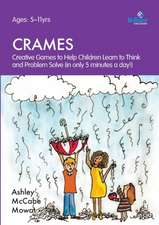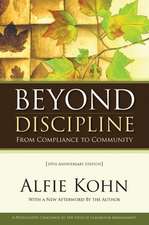ISLLC Standards in Action, The: A Principal's Handbook
Autor Carol Engleren Limba Engleză Paperback – 17 mar 2004
Sponsored by the Interstate School Leaders Licensure Consortium, the ISLLC Standards offer benchmarks for professional excellence that are tied to licensure and entry year principal programs throughout the nation.
The ISLLC Standards in Action: A Principal's Handbook demonstrates how these standards have been implemented at schools and districts across the country. 120 programs and practices are profiled in this book. They show you how to:
- create a school mission statement and communicate it to your entire community
- develop school-wide literacy by celebrating it
- establish a nuts & bolts committee to review and tweak school policies and procedures
- implement a Safe School Helpline
Each profile summarizes the program's goals and links it to the ISLLC Standards. Also included are tips and strategies to help you adapt and implement it in your own school or district.
| Toate formatele și edițiile | Preț | Express |
|---|---|---|
| Paperback (1) | 108.44 lei 6-8 săpt. | |
| Taylor & Francis – 17 mar 2004 | 108.44 lei 6-8 săpt. | |
| Hardback (1) | 416.35 lei 6-8 săpt. | |
| Taylor & Francis – 9 aug 2017 | 416.35 lei 6-8 săpt. |
Preț: 108.44 lei
Preț vechi: 130.92 lei
-17% Nou
Puncte Express: 163
Preț estimativ în valută:
20.75€ • 21.62$ • 17.18£
20.75€ • 21.62$ • 17.18£
Carte tipărită la comandă
Livrare economică 03-17 aprilie
Preluare comenzi: 021 569.72.76
Specificații
ISBN-13: 9781930556775
ISBN-10: 1930556772
Pagini: 160
Dimensiuni: 178 x 254 x 10 mm
Greutate: 0.27 kg
Ediția:1
Editura: Taylor & Francis
Colecția Routledge
Locul publicării:Oxford, United Kingdom
ISBN-10: 1930556772
Pagini: 160
Dimensiuni: 178 x 254 x 10 mm
Greutate: 0.27 kg
Ediția:1
Editura: Taylor & Francis
Colecția Routledge
Locul publicării:Oxford, United Kingdom
Public țintă
Professional Practice & DevelopmentCuprins
Chapter 1 Vision Values: ISLLC Standard 1; Chapter 2 Culture Counts: ISLLC Standard 2; Chapter 3 Safe and Sound: ISLLC Standard 3; Chapter 4 Community Connections: ISLLC Standard 4; Chapter 5 Ethics Embodied: ISLLC Standard 5; Chapter 6 Politics, Please: ISLLC Standard 6;
Descriere
Descriere de la o altă ediție sau format:
Because the analysis of copious amounts of data and the preparation of custom reports often take away time from true research, the automation of these processes is paramount to ensure productivity. Exploring the core areas of automation, report generation, data acquisition, and data analysis, Automated Data Analysis Using Excel illustrates how to minimize user intervention, automate parameter setup, obtain consistency in both analysis and reporting, and save time through automation.
Focusing on the built-in Visual Basic for Applications (VBA) scripting language of Excel the book shows step-by-step how to construct useful automated data analysis applications for both industrial and academic settings. It begins by discussing fundamental elements, the methods for importing and accessing data, and the creation of reports. The author then describes how to use Excel to obtain data from non-native sources, such as databases and third-party calculation tools. After providing the means to access any required information, the book explains how to automate manipulations and calculations on the acquired data sources. Collecting all of the concepts previously discussed in the book, the final chapter demonstrates from beginning to end how to create a cohesive, robust application.
With an understanding of this book, readers should be able to construct applications that can import data from a variety of sources, apply algorithms to data that has been imported, and create meaningful reports based on the results.
Because the analysis of copious amounts of data and the preparation of custom reports often take away time from true research, the automation of these processes is paramount to ensure productivity. Exploring the core areas of automation, report generation, data acquisition, and data analysis, Automated Data Analysis Using Excel illustrates how to minimize user intervention, automate parameter setup, obtain consistency in both analysis and reporting, and save time through automation.
Focusing on the built-in Visual Basic for Applications (VBA) scripting language of Excel the book shows step-by-step how to construct useful automated data analysis applications for both industrial and academic settings. It begins by discussing fundamental elements, the methods for importing and accessing data, and the creation of reports. The author then describes how to use Excel to obtain data from non-native sources, such as databases and third-party calculation tools. After providing the means to access any required information, the book explains how to automate manipulations and calculations on the acquired data sources. Collecting all of the concepts previously discussed in the book, the final chapter demonstrates from beginning to end how to create a cohesive, robust application.
With an understanding of this book, readers should be able to construct applications that can import data from a variety of sources, apply algorithms to data that has been imported, and create meaningful reports based on the results.









